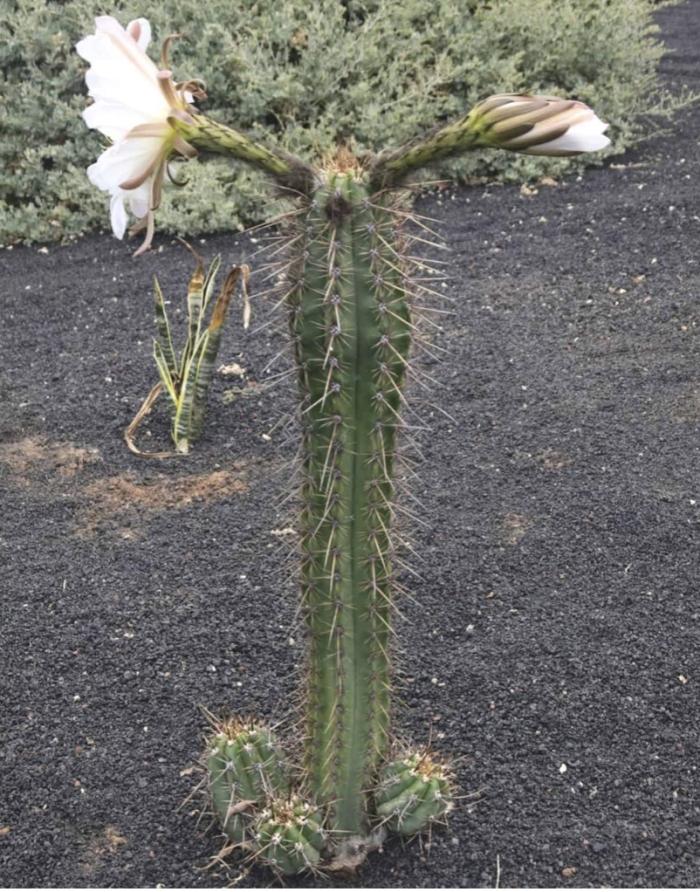Echinopsis lageniformis
Achuma Cactus; Bolivian Torch

Description
Bolivian Torch Cactus has four to eight wide set ribs with spines set 1-2 inches apart in clusters. The main body can be a variety of hues from green to a bluish color. Their spines can be a light golden color to a deeper brown. The spines grow in groups of four from the areoles of the cactus. With two to four inch long spines, Bolivian Torch Cactus is a plant you want to take seriously. This cactus grows straight like a pole but tends to be shorter than many other cacti in its region. Some might even call it unimpressive. Contrary to this belief, Bolivian Torch Cactus is often highly sought out by ornamental cactus collectors. The Scientific name for Bolivian Torch Cactus is Echinopsis lageniformis; it was previously Trichocereus bridgesii. More common names for Bolivian Torch Cactus include Bolivian Torch and Cactus of the Four Winds. Because it is highly adaptive and drought resistant, Bolivian Torch Cactus is the easiest mescaline cactus to care for. They require very low humidity and only require intense care when it comes to fertilization and repotting. Bolivian Torch Cactus likes to be in the sun; it requires full light 6-8 hours per day. If the sun becomes too blazing in the summertime, your Bolivian Torch Cactus will need to be shaded and given a break to avoid being scorched. Gravely, well draining soil that is fertile is best for Bolivian Torch Cactus. You can use a mix of two parts vermiculite, one part peat moss, and one part sand. A small amount of organic potting soil could also be added to the mixtures. The best pH for Bolivian Torch Cactus is between six and seven. Only water your Bolivian Torch Cactus when the soil is completely dry, but not so dry that it starts to harden into a puck. When watering, allow the excess water to completely drain out of the holes in the bottom of the pot. Make sure to empty any tray or dish under the container to avoid excess moisture. Bolivian torch cactus is drought resistant and stores water inside itself to survive the high temperatures and dry environment it naturally grows in. The best temperature for Bolivian Torch Cactus is between 68F and 95F. If temperatures reach below 50F or above 95F, it can stunt your cactus’ growth. Your Bolivian Torch Cactus will move into dormancy at these temperatures. In the spring, summer and fall, fertilize your Bolivian Torch Cactus once a month with a liquid fertilizer. A small amount of fertilizer such as eggshell powder or vermicompost can be added to the soil during repotting in early spring or fall. Bolivian Torch Cactus has a beautiful white blossom that is 8 inches long and 4 inches in diameter. The bloom comes out of the top of the cactus head. Once the flower has been pollinated, it will start to grow into a fruit. The fruit of the Bolivian Torch Cactus is edible. The fruit is ready to be picked when it turns red.
Plant Type
Cactus
Height Range
12-25'
Width Range
Flower Color
White
Flower Season
Spring, Summer
Leaf Color
Blue Green
Bark Color
n/a
Fruit Color
n/a
Fruit Season
n/a
Sun
Full
Water
Low
Growth Rate
Fast
Soil Type
Sandy, Loam
Soil Condition
Rich, Well-drained, Dry
Soil pH
Neutral
Adverse Factors
Thorns/Spines
Design Styles
Mediterranean, Ranch
Accenting Features
Showy Flowers, Specimen, Unusual Foliage
Seasonal Interest
Spring, Summer
Location Uses
Entry, Patio, Raised Planter, Walkways, With Rocks
Special Uses
Container, Small Spaces, Hanging Baskets
Attracts Wildlife
n/a
Water Saving Tip:
Change spray sprinklers to low-flow bubbler or drip systems.
Shrubs and trees are ideal candidates for this type of irrigation because the water is applied directly to the root zones.